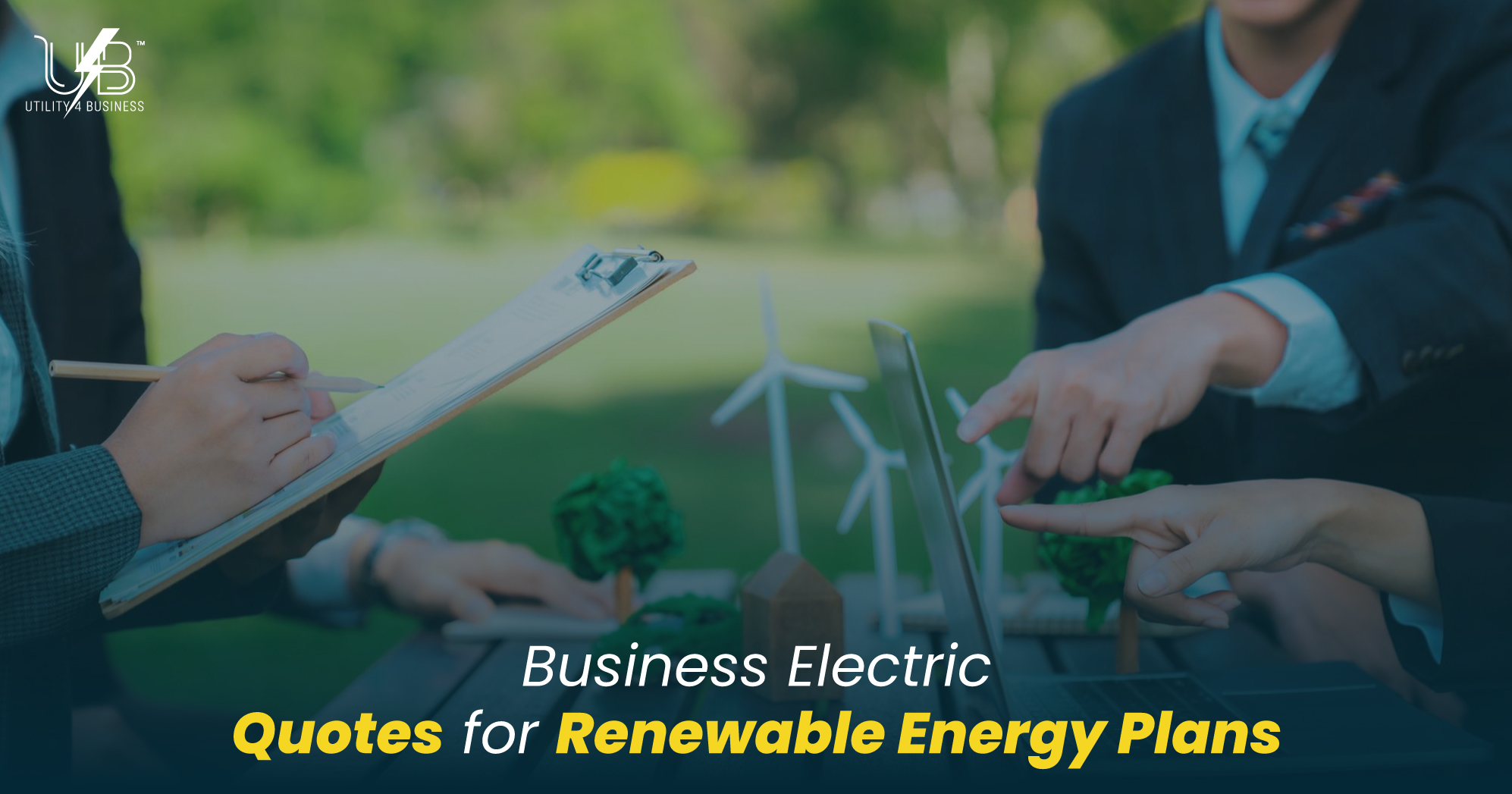Business Electric Quotes for Renewable Energy Plans
Compare Renewable Business Electricity Quotes

Choosing a renewable electricity plan for a UK business should not feel like guesswork. Quotes often present unit rates, standing charges, green labels, and contract terms in different ways, which makes fair comparison difficult. This guide explains what “renewable” means on a business electricity quote, how to read each cost line with confidence, and how Utility4Business helps you secure a plan that supports both your budget and your sustainability goals. The aim is simple: clear, practical steps that help you act, not theory that adds noise.
Why Businesses Are Moving To Renewable Electricity
Most organisations now want lower-carbon operations and more stable energy costs. Renewable electricity contracts help with both aims. When you buy a renewable plan, your supplier matches your consumption with electricity from recognised renewable sources, using certificates that prove origin. This reduces market-based Scope 2 emissions and supports customer and stakeholder expectations on climate action. It can also strengthen your position in tenders that ask for green power, which is now common across public and private sector procurement.
Cost matters as much as carbon. Many firms want predictable bills over the contract term. A well-timed fixed quote can provide price certainty for the period you choose, while a structured or pass-through contract can give more control if you prefer transparency on each component. The right choice depends on your usage pattern, risk appetite, and governance. Utility4Business guides you through those choices and presents them in a clean, comparable format so you can judge value with confidence.
What “Renewable” Means On A UK Business Electricity Quote
In the UK, “green” or “renewable” retail tariffs are usually backed by Renewable Energy Guarantees of Origin (REGOs). Each REGO represents one megawatt-hour of electricity from an eligible renewable source that has been put on the grid. Suppliers use REGOs to match your annual consumption with renewable generation. This is an accounting match, not a private wire from a wind farm to your building, so your lights do not physically run on a specific turbine. The accounting match is what supports your market-based Scope 2 reporting and your environmental claims.
Two questions help you assess a renewable claim:
- Proof Of Origin
- Ask the supplier to confirm that the tariff is backed by UK REGOs and to provide disclosure for the relevant period. Keep this evidence with your audit and ESG files. If your company reports across several countries, ensure the certificates and disclosure align with your reporting standards.
- Claims Of “Extra Impact”
- Some offers imply that your purchase builds new renewable capacity. That effect, often called “additionality,” requires more than standard certificate matching. If it matters to you, ask how the contract supports new projects and request clear documentation rather than marketing language.
If you want a guaranteed link to a named project and a stronger story about impact, you may explore a Corporate Power Purchase Agreement (CPPA), which is different from a standard retail tariff. We cover CPPAs later in this guide.
The Parts Of A Business Green Electricity Quote (And How To Compare Them)
A clear quote shows each element openly. When you run a business electricity comparison or when you compare business electricity offers through Utility4Business, review the following components one by one so that you compare like with like.
Unit Rate (p/kWh)
The unit rate is the price per kilowatt-hour you consume. Renewable and non-renewable quotes can have similar unit rates because the certificate cost is relatively small compared with wholesale, network, and policy costs. Your meter profile class, credit position, region, and consumption shape also influence the rate. Watch for quotes that look low but rely on optimistic usage assumptions; always check them against your actual data.
Standing Charge (p/Day)
This daily charge covers fixed network and policy costs. It varies by region and supplier. Standing charges continue to apply to green tariffs, and they can differ significantly between offers. Evaluate them across the full contract term, not in isolation, as a higher standing charge with a lower unit rate may still produce the lowest annual spend for your site.
Climate Change Levy (CCL)
Most businesses pay the CCL on electricity. HM Revenue & Customs sets the rates and updates them periodically. Some energy-intensive organisations with a Climate Change Agreement qualify for discounts. Make sure each quote shows whether it includes CCL in the unit rate or lists it separately. When you compare offers, place them on the same footing.
VAT
Most business energy bills carry VAT at 20%. Some small sites qualify for 5% VAT under de minimis rules, and charities may also qualify for the reduced rate. If you think a site should receive 5% but the bill shows 20%, ask the supplier to apply the correct rate and adjust past bills where necessary. Utility4Business flags these cases during the quote review so you do not miss them.
Certificates And Disclosure Notes
For a renewable quote, look for a statement that your consumption will be matched with REGOs for the relevant disclosure period. Ask for a supplier letter or annual fuel mix disclosure and file it with your carbon records. This supports your market-based Scope 2 calculations and keeps your evidence in order for auditors or stakeholders.
Contract Length, Price Type, And Volume Assumptions
Fixed all-inclusive rates offer simplicity but may include a risk premium. Pass-through or flexible contracts break out elements such as network charges and policy costs and pass them through at actual levels. These structures can suit larger users who want more control and visibility. Check whether the quote assumes a specific consumption band or time-of-use profile. If the assumptions do not match your real profile, the final cost can drift.
Non-Price Terms
Termination windows, credit conditions, objections handling, and change-of-tenancy clauses can matter more than a tiny price difference. Include them in your business electricity price comparison so that you avoid poor outcomes such as rollover onto out-of-contract rates or avoidable delays at go-live.
Renewable Options Beyond Standard Green Tariffs
Corporate Power Purchase Agreements (CPPAs)
A CPPA is a long-term contract to buy electricity directly from a renewable generator through the grid. You usually agree on a pricing structure linked to a named project, such as a wind or solar farm. CPPAs can offer price certainty and a clear link to real assets, but they add complexity around volume shape, balancing, and contract administration. They suit medium-to-large users who consume enough power to justify the work and who value the stronger connection to a specific project. If you want to explore this route, Utility4Business can help you scope your demand, assess contract models, and compare a CPPA against standard retail options.
On-Site Generation With The Smart Export Guarantee (SEG)
If you install solar PV or another qualifying technology on your site, the Smart Export Guarantee lets you receive payments for excess electricity you export to the grid. You can choose any SEG licensee, which means your export contract does not need to sit with the same company that supplies your import. This flexibility can improve your economics. When we run your business electricity tariff comparison, we can include an on-site scenario that projects your import reduction and likely export income, so you see a full picture rather than a single import quote.
Cost Versus Carbon: Getting Scope 2 Reporting Right
A renewable plan backed by recognised certificates can reduce your market-based Scope 2 emissions close to zero for electricity, while your location-based figure still reflects the Great Britain grid average. Many tenders and frameworks now ask for both figures. The best practice is simple: keep your certificate evidence and your supplier’s fuel mix disclosure, disclose both figures, and make sure the certificate period matches your reporting year. Utility4Business groups this paperwork into your quote pack so you have what you need at audit time.
Common Pitfalls In Renewable Business Electricity Quotes
Green Label Without Clarity
Some tariffs rely on wholesale electricity plus certificates bought at the end of the year. This can be valid for accounting, but it does not always show a strong additional impact. If you care about impact beyond matching, ask suppliers to explain how your purchase supports the new generation rather than existing output.
Ignoring CCL And VAT
Always compare quotes on a like-for-like basis, either all pre-tax or with taxes added consistently. HMRC sets the rules and rates, so keep an eye on changes. Utility4Business applies the current rules across your quotes and highlights any sites that may qualify for the reduced VAT rate.
Assumptions That Do Not Match Your Use
Quotes sometimes assume a smooth weekday profile or a consumption band that does not reflect your actual pattern. If your usage is seasonal or lumpy, this can shift the final cost. Share a recent 12-month usage file as part of the tender so that we can align assumptions and avoid mismatches.
Mismatch With Carbon Reporting
If you publish Scope 2 figures, make sure the tariff’s certificate evidence matches your reporting period. If you report across multiple geographies, check whether your certificates meet the recognition rules in those jurisdictions.
Rolling Over By Mistake
Missing a termination window can leave you with poor rates. Utility4Business tracks your dates and sets reminders to prevent silent rollovers.
How Utility4Business Supports Your Renewable Electricity Decision
Utility4Business focuses on UK business energy. Our workflow takes the confusion out of green quotes and turns it into a structured decision.
Properly Structured Business Electricity Comparison
We run a fair and transparent business electricity tariff comparison across our supplier panel and present each offer on the same basis. You see unit rates, standing charges, policy and network elements, CCL, VAT, and certificate status in a clear layout. We also present a projected annual cost based on your real usage file, not generic bands. If you prefer to compare business electricity rates by region or contract length, we can add views that make patterns obvious at a glance.
Renewable Evidence And Certificate Clarity
For green quotes, we collect statements on fuel mix and REGOs and align the disclosure period with your reporting year. If you need extra assurance, we request a supplier confirmation letter that references certificate coverage for your consumption. We include these documents in your pack so you can file them straight into your ESG records.
Guidance On CCL, VAT, And Low-Usage Relief
We highlight the current CCL and VAT treatment on each quote and flag any sites that may qualify for the reduced VAT rate under de minimis rules. Where we see a mismatch, we draft the wording you can send to suppliers to correct the rate on future bills and adjust past invoices where appropriate.
Options Beyond A Simple Fixed Green Tariff
If you want on-site generation with SEG export payments, we run an import-plus-export scenario to show how the pieces fit. For larger users who want a CPPA, we outline pricing models, balancing considerations, and governance steps before you engage with generators and suppliers.
Contract Timing And Risk
There is no business energy price cap, so timing and competition matter. We watch market conditions, set practical tender windows, and advise on contract length. The result is a decision that balances today’s price with tomorrow’s uncertainty in a sensible way.
Switching Support And Ongoing Checks
Once you choose, Utility4Business manages sign-up, objections, meter reads, and go-live. We also review first bills to catch errors early and set renewal reminders so you never drift into out-of-contract rates.
Step-By-Step: How To Compare Renewable Electricity Quotes With Confidence
Collect Your Data
Export the last 12 months of bills or half-hourly data. Confirm meter numbers and supply addresses. If you operate several sites, check whether your contracts align or end on different dates.
Set The Brief
Decide whether you want a 100% certificate-backed renewable tariff, an on-site plus SEG route, or a CPPA exploration. Pick a contract length that fits your plans. Let us know whether you prefer fixed all-inclusive rates or pass-through elements for network and policy costs.
Request Like-For-Like Quotes
Ask all suppliers for the same start date, term, and usage assumptions. Require separate lines for standing charge, unit rate, CCL, and VAT. We do this for you and present the results in a normalised format.
Check The Green Evidence
Make sure the quote confirms certificate coverage and disclosure for the right period. Keep the documentation.
Evaluate Total Cost
Compare the fully loaded annual cost at your measured usage. Beware of headline unit rates that exclude policy or network elements which appear elsewhere on the bill.
Review Non-Price Terms
Scan termination windows, credit conditions, and change-of-tenancy rules. These can add hidden costs if you miss details.
Confirm VAT And CCL
If any sites qualify for 5% VAT, document the basis and ask the supplier to apply it. Keep the proofs with your records.
Align With Carbon Reporting
Store certificate statements and fuel mix disclosure for your market-based Scope 2 file. If you report across several regions, confirm recognition rules early.
Decide, Sign, And Track Renewal
Choose the offer that balances cost, risk, and sustainability for your operations. Log a reminder for renewal six months ahead so you have time to run a fresh tender.
Utility4Business can run this entire process, present a clean business electricity comparison pack, and manage your switch end-to-end. You keep control of the decision while we handle the details.
Price Trends, Caps, And Why Timing Matters
Headlines about the domestic price cap can be confusing for businesses. The Ofgem cap applies to households on standard variable tariffs. It does not limit business electricity rates. Business prices move with wholesale markets, network charges, policy costs, and supplier risk. This is why competitive tendering and good timing matter. Utility4Business checks market conditions and helps you choose a contract length that balances certainty with flexibility.
When wholesale markets fall, you may benefit by setting a longer term to lock in value. When they rise, a shorter term may make sense so you can revisit prices sooner. There is no single answer for every firm. Your usage profile, credit position, and growth plans guide the choice, and we reflect those factors in our recommendation.
When A CPPA Or On-Site Generation Makes Sense
Medium-To-Large Sites With Stable Demand
If your consumption is large and steady, a CPPA can align your electricity with a specific renewable asset and provide a long-term price structure. It needs careful work on volume shape and balancing, but can support stronger environmental claims and investor messaging.
Sites With Viable Roofs Or Land
If your site can host solar PV or other technology, on-site generation can cut grid import and earn SEG income on exports. In some cases, the combined effect of reduced import and export payments and a competitive green import tariff produces the best overall result. Utility4Business can model such scenarios so you can see long-term effects in a single view, rather than guessing from separate quotes.
Avoiding “Greenwashing” While Keeping Costs Down
A practical way to keep your plan credible and fair-priced is to combine three actions:
Insist On Evidence
Ask for certificate coverage and the relevant disclosure period in the quote pack. File it with your ESG documentation.
Decide How Much “Extra” You Want
If you want impact beyond standard certificate matching, ask suppliers about mechanisms that support new build and request clear documentation rather than broad claims.
Compare On Total Cost, Not Just The Label
Renewable tariffs can be competitive once you adjust for taxes and your actual usage pattern. Look beyond the headline rate and evaluate the full annual cost at your measured consumption.
Utility4Business builds these checks into our business electricity comparison process so you can move quickly without losing diligence.
What A Good Comparison Looks Like
A strong comparison pack from Utility4Business shows:
- Contract start date and term for each offer
- Unit rate (p/kWh) and standing charge (p/day)
- Treatment of policy and network elements, CCL, and VAT
- Certificate status and disclosure period for green offers
- Estimated annual cost at your measured usage
- Notes on non-price terms such as termination, credit, and objections
- An appendix for Scope 2 evidence, ready for your audit files
This gives you a clean basis to choose among a 100% renewable retail tariff, an on-site plus SEG solution, and—if relevant—a CPPA from a named generator. In every case, our aim is a clear recommendation that shows cost, risk, and carbon side by side.
Conclusion
Renewable electricity is now a standard business choice rather than a niche option. The value comes from three things: a transparent quote, clear proof of renewable origin, and contract terms that fit your usage and risk appetite. Keep your certificate evidence, disclose both market-based and location-based Scope 2 figures, and negotiate on a like-for-like basis so price differences mean what you think they mean.
Utility4Business helps by running a thorough business electricity comparison that places renewable and conventional quotes on equal footing, normalises taxes and charges, and gathers the evidence your ESG and finance teams need. We also explore on-site generation with SEG export and, for larger users, CPPA options. With a clean comparison pack, you can choose a cost-effective plan that strengthens your sustainability story and supports your long-term operations.
If you are ready to compare business electricity for renewable plans, share your latest 12-month usage and your preferred contract term. We will return normalised quotes with certificate coverage, CCL and VAT treatment, and a simple recommendation based on total cost, risk, and carbon impact.
Find This Article Helpful? Share It Now!
At Utility4Business, we offer top-notch customer support and business utility solutions for businesses across the UK. Consider sharing this article and helping others discover how our expertise can add value to their business success.

Read Our Latest Posts
Explore our latest blog posts and learn how Utility4Business can support your business growth with tailored utility solutions and services. Stay ahead of the curve with the latest information from industry experts and take advantage of our user-friendly comparison services to find the best business deals.


Get Connected
At Utility4Business, our team of experts can help you figure out the highest-value business utility deals that will help your business grow over time.


